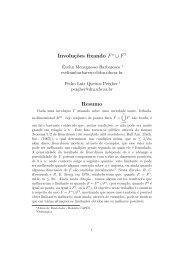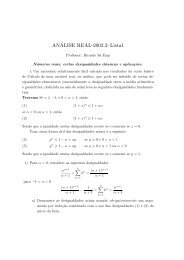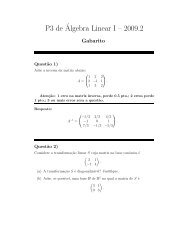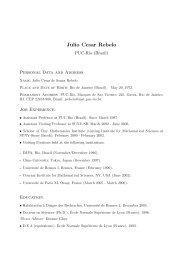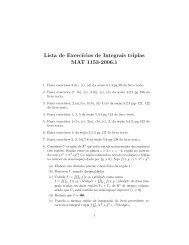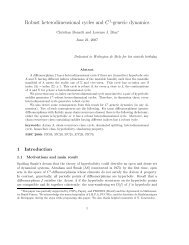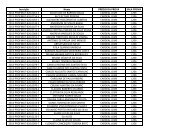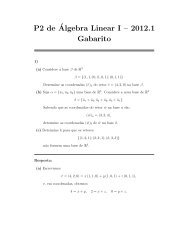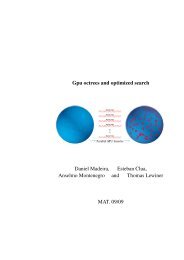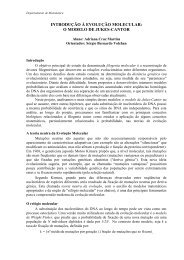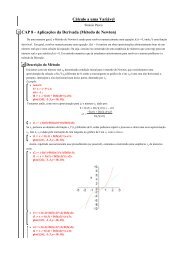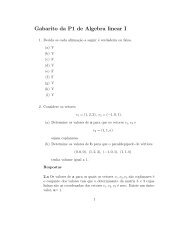Schnyder woods for higher genus triangulated surfaces with ...
Schnyder woods for higher genus triangulated surfaces with ...
Schnyder woods for higher genus triangulated surfaces with ...
Create successful ePaper yourself
Turn your PDF publications into a flip-book with our unique Google optimized e-Paper software.
Luca Castelli Aleardi, Eric Fusy and Thomas Lewiner 2<br />
(a) Related Work<br />
Vertex spanning tree decompositions<br />
In the area of tree decompositions of graphs there exist<br />
some works dealing <strong>with</strong> the <strong>higher</strong> <strong>genus</strong> case. We mention<br />
one recent attempt to generalize <strong>Schnyder</strong> <strong>woods</strong> to the<br />
case of toroidal graphs [5] (<strong>genus</strong> 1 <strong>surfaces</strong>), based on a<br />
special planarizing procedure. In the <strong>genus</strong> 1 case it is actually<br />
possible to choose two adjacent non-contractible cycles,<br />
defining a so-called tambourine, whose removal makes the<br />
graph planar; the graph obtained can thus be endowed <strong>with</strong><br />
a <strong>Schnyder</strong> wood. In the triangular case this approach yields<br />
a process <strong>for</strong> computing a partition of the edges into three<br />
edge-disjoint spanning trees plus at most 3 edges. Un<strong>for</strong>tunately,<br />
as pointed out by the authors, the local properties of<br />
<strong>Schnyder</strong> <strong>woods</strong> are possibly not satisfied <strong>for</strong> a large number<br />
of vertices, because the size of the tambourine might be arbitrary<br />
large. Moreover, it is not clear how to generalize the<br />
method to <strong>genus</strong> g ≥ 2.<br />
Planarizing surface graphs<br />
A natural solution to deal <strong>with</strong> <strong>Schnyder</strong> <strong>woods</strong> (designed<br />
<strong>for</strong> planar graphs) in <strong>higher</strong> <strong>genus</strong> would consist in per<strong>for</strong>ming<br />
a planarization of the surface. Actually, given a surface<br />
S of <strong>genus</strong> g and size n, one can compute a cut-graph or<br />
a collection of 2g non-trivial cycles, whose removal makes<br />
S a topological disk (possibly <strong>with</strong> boundaries). There is<br />
a number of recent works [8, 37, 14, 22, 23, 36] dealing<br />
<strong>with</strong> interesting algorithmic challenges concerning the efficient<br />
computing of cut-graphs, optimal (canonical) polygonal<br />
schemas and shortest non-trivial cycles. For example<br />
some works make it possible to compute polygonal schemas<br />
in optimal O(gn) time <strong>for</strong> a <strong>triangulated</strong> orientable manifold<br />
[23, 36]. Nevertheless we point out that a strategy based<br />
on such planarizing approach would not be best suited <strong>for</strong><br />
our purposes. From the combinatorial point of view this<br />
would imply to deal <strong>with</strong> boundaries of arbitrary size (arising<br />
from the planarizing procedure), as non-trivial cycles can<br />
be of size Ω( √ n), and cut-graphs have size O(gn). Moreover,<br />
from the algorithmic complexity point of view, the<br />
most efficient procedures <strong>for</strong> computing small non-trivial cycles<br />
[8, 22] require more than linear time, the best known<br />
bound being currently of O(n log n) time.<br />
<strong>Schnyder</strong> trees and graph encoding<br />
One of our main motivations <strong>for</strong> generalizing <strong>Schnyder</strong><br />
<strong>woods</strong> to <strong>higher</strong> <strong>genus</strong> is the great number of existing<br />
works in the domain of graph encoding and mesh compression<br />
that take advantage of spanning tree decompositions<br />
[21, 30, 34], and in particular of the ones underlying<br />
<strong>Schnyder</strong> <strong>woods</strong> (and related extensions) <strong>for</strong> planar<br />
graphs [2, 11, 12, 17, 19, 29]. The combinatorial properties<br />
of <strong>Schnyder</strong> <strong>woods</strong> and the related characterizations (canonical<br />
orderings [20]) <strong>for</strong> planar graphs yield efficient procedures<br />
<strong>for</strong> encoding tree structures based on multiple parenthesis<br />
words. In this context a number of works have been<br />
proposed <strong>for</strong> the simple compression [19] or the succinct encoding<br />
[12, 11] of several classes of planar graphs. More recently,<br />
this approach based on spanning tree decompositions<br />
has been further extended to design a new succinct encoding<br />
of labeled planar graphs [2]. Once again, the main ingredient<br />
is the definition of three traversal orders on the vertices<br />
of a triangulation, directly based on the properties of <strong>Schnyder</strong><br />
<strong>woods</strong>. Finally we point out that the existence of minimal<br />
orientations (orientations <strong>with</strong>out counter-clockwise directed<br />
cycles) recently made it possible to design the first<br />
optimal (linear time) encodings <strong>for</strong> some popular classes of<br />
planar graphs. For the case of triangulations and 3-connected<br />
plane graphs [17, 29] there exist some bijective correspondences<br />
between such graphs and some special classes of<br />
plane trees, which give nice combinatorial interpretations of<br />
enumerative <strong>for</strong>mulas originally found by Tutte [35]. Very<br />
few works have been proposed <strong>for</strong> dealing <strong>with</strong> <strong>higher</strong> <strong>genus</strong><br />
embedded graphs (corresponding to manifold meshes): this<br />
is due to the strong combinatorial properties involved in the<br />
planar case. Nevertheless, the topological approach used by<br />
Edgebreaker (using at most 3.67 bits per vertex in the planar<br />
case) has been successfully adapted to deal <strong>with</strong> <strong>triangulated</strong><br />
<strong>surfaces</strong> having arbitrary topology: orientable manifold <strong>with</strong><br />
handles [26] and also multiple boundaries [25]. Using a different<br />
approach, based on a partitioning scheme and a multilevel<br />
hierarchical representation [9], it is also possible to obtain<br />
an encoding of a triangulation of fixed <strong>genus</strong> g, having<br />
f faces and n vertices, requiring 2.175f +O(g log f)+o(f)<br />
bits (or 4.35n + o(gn) bits) which is asymptotically optimal<br />
<strong>for</strong> <strong>surfaces</strong> <strong>with</strong> a boundary: nevertheless, the amount of additional<br />
bits hidden in the sub-linear o(n) term can be quite<br />
large, of order Θ( n<br />
log n<br />
log log n).<br />
(b) Contributions<br />
Our first result consists in defining new traversal orders<br />
of the vertices of a triangulation of <strong>genus</strong> g, as an extension<br />
of the canonical orderings defined <strong>for</strong> planar graphs.<br />
We are also able to provide a generalization of the <strong>Schnyder</strong><br />
labeling to the case of <strong>higher</strong> <strong>genus</strong> <strong>surfaces</strong>. The major<br />
novelty is to show that the linear time algorithm designed <strong>for</strong><br />
the planar case can be extended in a nontrivial way in order<br />
to design a traversal of a <strong>genus</strong> g surface. This induces<br />
a special edge coloring and orientation that is a natural generalization<br />
of the corresponding planar structure. In particular,<br />
the spanning property characterizing <strong>Schnyder</strong> wood is<br />
again verified almost everywhere in the <strong>genus</strong> g case. Our<br />
approach involves the implicit computation of cut-graphs, as<br />
one would expect. Nevertheless, our strategy is really different<br />
from the one based on planarizing procedures: even if our<br />
cut-graphs and non-trivial cycles can have arbitrary size, we<br />
show that it is always possible to propagate the spanning condition<br />
of <strong>Schnyder</strong> <strong>woods</strong> even along this cuts in a coherent<br />
and natural manner. This property, and in particular the fact<br />
that there are only few exceptions to the spanning condition,<br />
allow us to characterize our graph decomposition in terms of<br />
Preprint MAT. 18/08, communicated on September 1 st , 2008 to the Department of Mathematics, Pontifícia Universidade Católica — Rio de Janeiro, Brazil.



